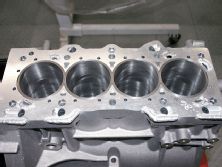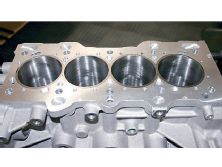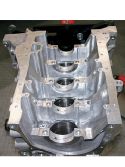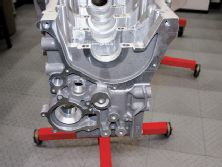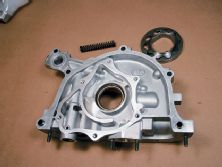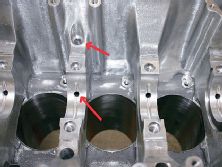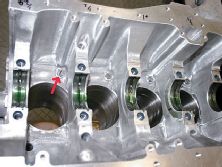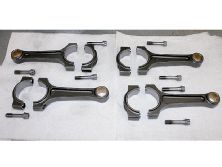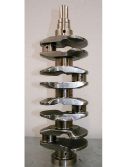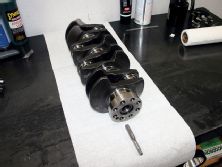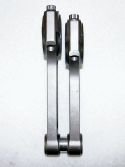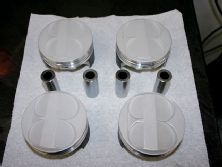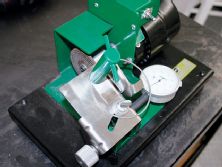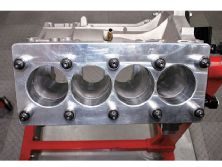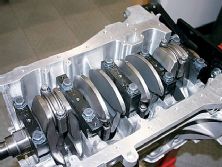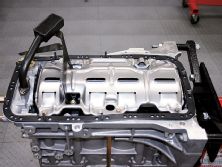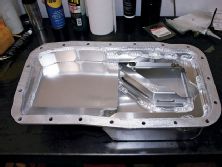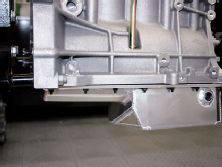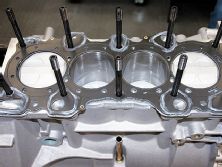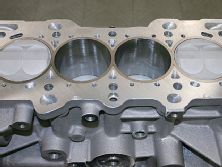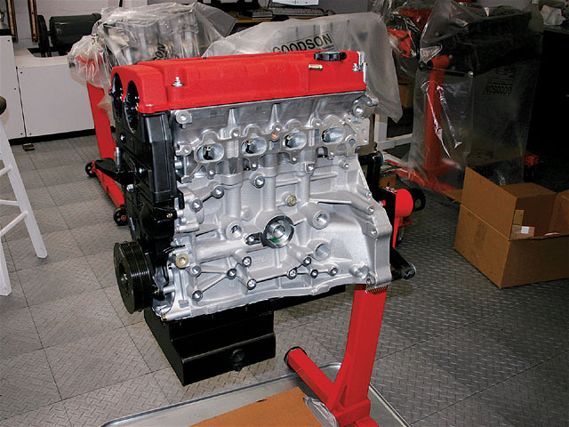 | Dart B-series Engine Block Build - Pound For Pound
| Dart B-series Engine Block Build - Pound For Pound
Last month we proposed building a 150 horsepower-per-liter B-series normally aspirated engine that had to run on pump gas and propel a full-dress Honda chassis, including a kid seat or two. There are no restrictions on engine size or parts, but because it must use pump gas and be a true daily driver, the build will not be as easy as a drunk sorority pledge during Rush week (regrettably our gas is only 91 octane, unlike most of the country, which gets 93). It also needs to be an engine that will last many thousands of miles, not just a winter. All these things make the job a challenge.
We chose a Dart B20-style block for the project. It boasts an 84.5mm bore, the tall deck option for longer rods, a Crower 92mm stroker crank pushing and pulling custom Crower rods, a GSR head and lots of Endyn components, like pistons, cams, valvetrain, and intake manifold. The combo yields 2.06 liters or 126 cubes. Take out your calculator and you get a target horsepower of 309. That's pretty damn high for a normally aspirated engine, but we are talking about crank horsepower, not wheel horsepower. We'll use an engine dyno for putting this engine to its final test.
Like last time, the owner of Endyn, Larry Widmer, is going to tell the story. Larry is a genuine Texas character and has worked for the likes of Ford, Toyota, Roger Penske, General Dynamics, and MSD. His engines have won an Indy 500, a NASCAR title, and multiple Pro Stock titles. Herewith is how Endyn assembles a short block in detail, with some of Widmer's best secrets. Next time we'll uncover Larry's true specialty, the head.
Honda Tuning: Ok, we got the Dart block for its rigidity. You said it's strong and really supports the crank and mains at high RPMs in a way a stock block can't. It also overcomes the shortcomings associated with sleeving a stock block. What's next? Is it ready for assembly of out the box?Larry Widmer: We can start at the top. The water passages in the block aren't exactly where we'd like them to be relative to the headgasket and the head. It's very important that we get efficient cooling in an engine, especially one that's running on marginal fuel. We weld certain areas and then open them so the passages align perfectly. Also, in two of the oil drain-back areas, we add some aluminum to the deck because it's just a little short. If we didn't, there might be oil seepage. It basically extends the surface to get a perfect gasket seal.
HT: You mean the edges are too short? Are Honda blocks the same way?LW: No, Honda blocks have enough material there, but the Darts need just a bit more so there's no chance of seepage.
HT: The top side is ready-what now?LW: Honda blocks are die cast, whereas Dart blocks are sand-cast. Look at a Honda block and you'll notice how smooth it is relative to an aftermarket version. Internally and externally the Dart block is much rougher, which is why we spend about a half-day going through it to get rid of the coarseness and porosity. This helps oil drain back to the pan faster. We also open up all those passages and polish them for even greater efficiency. Honda heads need lots of oil to ensure valvetrain longevity, so we want to get the oil back to the pan fast to get it circulating.
HT: You also modify the oil pump for greater flow.LW: Right, but we start with the Dart's main oil passage. As delivered from Dart, the passage isn't large enough for use with our modified pump, so we drill it out so that it kind of acts as an oil "plenum." This lets us put a whole lot more oil on that side of the block. We also clean, smooth, and radius the little passages that feed the main bearings. We want to make sure there are no small edges to interfere with oil flow, or any little bits of metal that could break off and cause a problem.
HT: So the Dart block is a good foundation, but needs some prep.LW: They do a rough machine on the deck, align bore, and align hone the bottom, but that's about it. [Endyn] blueprints an engine of this performance level. Everything has to be to a precise spec so that we can use all Honda bearings. I can't emphasize enough the importance of using Honda bearings and its system. If you use an aftermarket bearing, it's a one bearing size fits all. Bearing fitment is one reason Honda engines are as dependable as they are, especially when you're going to increase power.
HT: Aren't Honda bearings so awesome that NASCAR teams use them?LW: NASCAR engine builders have cranks made that can accept standard Honda bearing diameters. Because there are so many different sizes of bearings, the engine builder can have exactly the same clearance on every journal. That's exactly what we're going to do here.
HT: Is the block prepped at this point? What about the water passages inside the block? Dart says they're enlarged.LW: When sand cast parts are created, the casting has to be thick. It was necessary for Dart to make the outer walls and the water-jacketing farther outboard so they could get more water around the cylinders. They may not have as much water around the cylinders as a stock block, but there's enough.
The best thing about Dart blocks is that their cylinders stay round. While the sleeves themselves are thin [relative to most aftermarket sleeves], the robust aluminum structure around them provides plenty of support. The fact that the thickness of the sleeves is the same all the way around also means that they expand evenly as temperatures increase, keeping the bores round for ring seal.
HT: What about the bottom side of the block? Do you use the oil squirters?LW: There isn't sufficient space for the squirters with the stroke combination we're building here. However, the factory squirters are great in applications where stock-style cast pistons are in use. And while properly engineered forged pistons are capable of operating at higher temperatures and loads, assuming there's room for them, we still incorporate the squirters in engines we build that operate for long periods of time at high RPM in the upper gears (like road-racing applications). In drag racing engines we build, I never use oil squirters because we want to limit the amount of oil that finds its way to the cylinder walls and ultimately to the combustion event where it invites detonation.
HT: Looking at the Crower 92mm crank, it seems ready. Do you do anything like knife edging, balancing, or some other kind of prep for the crank?LW: No, the cranks are pretty good. We do check the balance on all the cranks we use, and Crower's are usually pretty close as we receive them. If we were building for drag racing or something where we're searching for 2 or 3 additional horsepower we'll remove some weight, but for this application it's not worth fooling with.
All in all, the Crower cranks are very nice pieces when it comes to straightness and journal consistency, but one thing you definitely have to check is the thread-depth on the flywheel boltholes. As received from Crower, these holes are not all tapped to the same depth, and they're also not all tapped to the same depth as a stock Honda crank. I also recommend using new bolts and torquing them 5 foot pounds more than Honda's spec. A drop of red Loctite on there is also a good idea, especially if you're running an aluminum flywheel.
HT: What about these custom-length Crower rods you had made?LW: The rod I had made for this thing is 5.885 inches (149.5 mm) long. It's not one of Crower's super light rods, so that if you want to switch to forced induction down the road you can keep these. These give a rod ratio of 1.62:1.
HT: On top of that rod we have an Endyn Rollerwave piston. What's Rollerwave?LW: Roller-Wave describes the mixture and pressure motion our pistons create in the combustion space. "Combustion space" is defined as the area between the combustion chamber and the top of the piston. The quench pad of our piston on the intake side is three-thousandths (0.003) of an inch higher than on the exhaust side. When the piston reaches Top Dead Center (TDC), the pressure wave created by that difference pushes the mixture to the exhaust side. Also, at TDC, the rod changes directions and that causes the exhaust side of the piston to flip up ever so slightly.
We have a slot in the top of the piston that basically connects the two exhaust valve reliefs, and that slot lines up exactly with the edge of the chamber on the exhaust side so when the piston does the flip, it creates a wall causing the pressure wave to be reflected and rolled over to the exhaust side. The fact that the exhaust valves are a latent heat source causes mixture ionization, making the exhaust side the ideal area to place the combustion process. If you light there, you light more of the mixture than you would if the mix is spread out.
We shape the entire area, from the piston top to the quench pads to the bottom of the head, to mechanically force this to happen. It causes the burn to be much more rapid and complete with less tendency for detonation. That's also what I call soft-head technology, something I started doing in the mid '80s.
HT: We'll look at the head in the next episode, but since this is a complete "system" type approach you're modifying the entire combustion chamber. What if I haven't sent my head to Endyn for all this matching? Will the Rollerwave pistons still do their thing?LW: Absolutely. I think we've got 45 different B-series pistons on the shelves just so we can make the best match for whatever combination. One of the reasons we don't have online sales is because being able to talk to customers and discuss their respective engine modifications allows us to make sure they get the ideal piston for each application.
HT: Makes sense, but I don't see a piston production facility in any of the pictures on your website. Whose pistons are you using?LW: We use our own. We don't make them: Wiseco makes them to our spec and ships them to us just after machining, and we do everything else. We can alter compression ratios here by machining the piston tops, and we hand radius all the edges, providing a brushed dome finish before balancing each piston. We even do our own coatings depending on the application. With all the Hondas and now Toyotas, Nissans, and Hyundais, I think we have nearly 100 truly custom pistons available. Using our Roller-Wave design pistons, you can generally run one full point more compression than you can with any other piston without correspondent detonation.
HT: Almost forgot the pan and the oil system-you rework the pump or something? Do you put in new gears?LW: No, I haven't seen a set of aftermarket gears that are worth a shit. The Honda ones work fine-we just measure everything and set it to minimum Honda clearances. That means less oil goes around the gears and we get more pressure by tightening it all up. Enlarging, radiusing and polishing the oil inlet and outlet passages also helps a great deal for flow and overall pump efficiency. The other thing we do is a custom bypass spring. We have 3 of them and we'll install the one that matches the engine best. As for the pan, I've tried a lot of them, but right now I'm using the Moroso drag race pan. We weld in a baffle all around the pan's sump area that prevents oil from climbing out under high-G situations. Combined with a modified factory windage baffle, it's a really tight fit, but works great.

